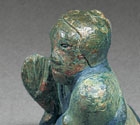J.J. Lally & Co., Oriental Art / New York City, New York
MenuPast Exhibition
Ancient Chinese Bronzes
March 19 - April 9, 2011
16.
A SET OF FOUR PAINTED BRONZE MAT WEIGHTS IN THE FORM OF LIUBO PLAYERS
Western Han Dynasty (206 B.C. – A.D. 8)
each figure compactly cast in the round, the men shown in various seated poses and with different facial expressions, playing or watching the game, all wearing long robes and with hair pulled back into a tight bun at the back, with extensive original painted decoration in red, blue, green, white, and black pigments extraordinarily well preserved, the interior of each hollow figure filled with lead.
Heights 2 3⁄4 inches – 3 3⁄8 inches (7 cm – 8.6 cm)
Exhibited
Asian Games: The Art of Contest
Asia Society Museum, New York, October 14, 2004 – January 16, 2005
Freer and Sackler Galleries, Washington D.C., February 26 – May 15, 2005
Middlebury College Museum of Art, Vermont, September 17 – December 11, 2005
A Bronze Menagerie: Mat Weights of Early China
Isabella Stewart Gardner Museum, Boston, October 5, 2006 – January 14, 2007
Published
Mackenzie and Finkel (eds.), Asian Games: The Art of Contest, New York, 2004, p. 43, no. 2:8 a-b
Wang, A Bronze Menagerie: Mat Weights of Early China, Boston, 2006, pp. 110-111, no. 12
In his caption for the illustration of this set of figural bronze weights in Asian Games: The Art of Contest, Mackenzie writes: “Weights were used in ancient China to hold mats in place. Larger weights were used for seating mats, but smaller ones such as this group may have been used to hold liubo throwing mats. … These weights probably represent players engaged in a drinking game that involves hand gestures. As is usual with such weights, one figure seems almost comatose, no doubt having been drunk under the table by his companions.”
Compare the set of four figural weights excavated from tomb no. 1 at Fujiagou, Lingtai county, Gansu province, now in the Lingtai County Cultural Center, illustrated in Zhongguo meishu quanji: diaosubian (Compendium of Chinese Works of Art: Sculpture), Vol. 2, Beijing, 1988, no. 75, where the figures are identified as dice players and the scene is described as follows: “…almost forgetting how to behave themselves, the dice thrower and his partner seem to be shouting at the top of their voices. When the thrower is ready to drop the dice, his partner is raising his left hand to boost his morale. Their opponents keep their mouths shut and are watching the act with bated breath.” The same set of bronze figural weights is also illustrated in Zhongguo qingtongqi quanji: Qin Han (Compendium of Chinese Bronzes: Qin and Han), Vol. 12, Beijing, 1998, no. 134, with description on p. 44. Compare also a group of four player-form bronze weights excavated in 1971 from Xi’an, Shaanxi province, now in the collection of the Xi’an City Historical Park, included in the special exhibition at the Empress Place, Singapore, and illustrated in the catalogue entitled Treasures from the Han, Singapore, 1990, p. 59.
Similar sets of bronze liubo player-form weights in museum and private collections are illustrated by Wang in Chinese Bronzes from the Meiyintang Collection, London, 2009, pp. 294-295, no. 149; in the collection of the Idemitsu Museum of Arts, illustrated in Ancient Chinese Arts in the Idemitsu Collection, Tokyo, 1989, pl. 253; and in the collection of Musées Royaux d’Art et d’Histoire, Brussels, illustrated by Deydier in Chinese Bronzes, Fribourg, Switzerland, 1980, p. 133, pl. 102.
西漢 彩繪四人博戲銅俑
高 7 至 8.6 厘米
